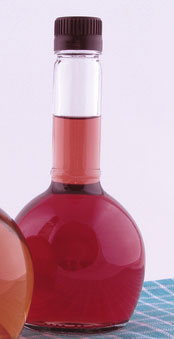Red wine vinegar
 |
|
Red wine vinegar has a high acid content and should be balanced carefully with other recipe ingredients. |
See also vinegar.
The acidic taste of red wine vinegar is a popular accompaniment to foods of a matching color. Hearty stews and heavy red sauces can always be livened up with a splash or two, as can Mexican dishes such as fajitas.
Varieties
You’ll find a wide selection of regular and flavored vinegars at any grocery, some of which are organically produced.
Gourmet markets and on-line retailers will also stock international brands that are well worth trying.
Raspberry red wine vinegar is gaining in popularity. It gives another interesting level of flavoring to basting sauces or as a salad dressing.
Buying Tips
Specialty vinegars in the more expensive range will undoubtedly taste the best. Mid-priced products are also recommended. Be cautious with the lower end of wine vinegars, however. The cheapest typically originate from an equally priced wine.
Storage Tips
Red wine vinegar will last a very long time, especially if refrigerated. Over time it may turn cloudy or show sediment. This will not affect the flavor.
In rare instances, harmless bacteria may cause a reaction that results in a white, mucous type of growth. In vinegar terms, this is known as “mother.” Remove it by straining and add a little red wine to improve the depth of flavor.
Usage Tips
• Use Red wine vinegar for de-glazing.
• Include in a marinade for tenderizing tough cuts of meat.
• Heat in a skillet and soften red cabbage.
Substitution Tips
Equal amounts of cider vinegar, sherry vinegar, or white wine vinegar.
Try one of our favorite red wine vinegar recipes:
Anita's Cole Slaw
Marinated Beef Brisket
Red Snapper Italiano





